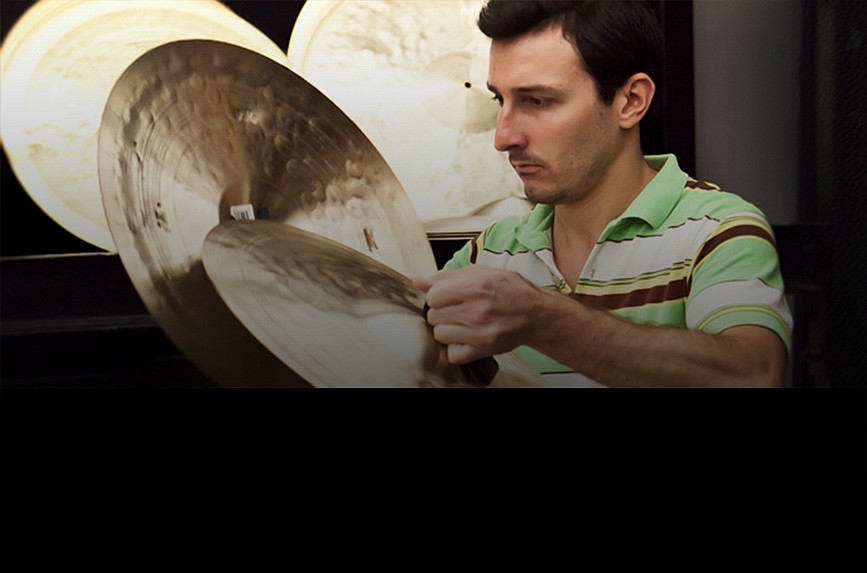- November 23, 2024
-
-
Loading

Loading

In 1964, I was on a scholarship as a Solo Chorister at the Tanglewood Festival. We ate, drank and sang music 24/7 and that meant, when we weren’t working, we were attending performances. At one of the Fromm contemporary concerts, a group of my friends and I found ourselves in paroxysms of laughter while we listened to a new piece of music. We just didn’t get its atonality and sputtering, stuttering rhythms and it sent us into giggle fits that shook our row of seats.
Suddenly, I felt a tap on my shoulder and, when I managed to pull myself together long enough to turn around, I found myself face to face with Aaron Copland, who gave me a look that withered any further smiles, no less sniggers for the rest of the concert.
This past Thursday, members of the Sarasota Orchestra, with percussionist George Nickson in the leading seat, offered a program called “Percussion Perfect” and, of the four well-chosen works, only one reminded me of those offending days at Tanglewood.
It was Mario Davidovsky’s “Flashbacks,” and it truly gave me flashbacks of the music written in the 1960s and 1970s; music I didn’t understand then and I don’t get now. Scored for 24 percussion instruments including marimba, vibraphone, glockenspiel, crotales (tuned bronze disks), three cymbals, three gongs, bass drum, temple blocks, woodblock, castanets, bongos, five toms (drums), claves (short, thick dowls), triangle, tambourine and guiro (a hollow gourd that makes a ratchet sound), all played by Nickson (who looked like a whirling dervish), the piece also included a flute, piccolo and alto flute (Betsy Hudson Traba), clarinet and bass clarinet (Calvin Falwell), violin (Jennifer Best Takeda), cello (Christopher Schnell) and the largest percussion instrument of them all, piano (Jonathan Spivey).
Oh – I should mention that the piano was “fixed,” or prepared, and Spivey spent much of his time reaching inside the instrument and doing some mysterious plucking and hitting, and at the end of the piece, the stage hands extricated a music stand that had been lying on its side, inside the piano, so Spivey would be able to see the music without the normal music rack getting in the way of his lunges.
“Flashbacks” is as hard to play and pull together as it is to hear. This is the kind of stuff composers were experimenting with in the mid-20th century and I’m glad to say we’ve moved beyond all that to music that incorporates those early etched ideas and makes them into many works with real beauty and meaning, over and beyond what they were trying back then. The funny thing is, “Flashbacks” was written in 1995 and why anyone would want to flashback to those earlier days of trial and error with a piece that’s much more trouble than it’s worth, is beyond me.
What came across, though, was the amazing talent of all the musicians involved, especially Nickson who just nailed it. It’s probably not something you’ll hear again but, for the virtuosity displayed by Nickson and his cohorts, it was worth my 11 minutes of agony.
Funny how you spend more time with a piece like the Davidovsky but, for those not there, I wanted you to get a sense of what we experienced. Maybe that’s why some of those concerts in the olden days were called “Happenings.”
The rest of the program was inventive, fascinating and comprehensible. Takemitsu’s “Rain Tree,” started the evening. It’s a brilliant work that begins with a poem, read in Japanese by timpanist Yoko Kita, and goes on with startlingly beautiful effects made by a trio of percussionists – Nickson, Kita and Bruce Lehman. Among them, they made music with their bells, marimbas and vibraphone that sent shimmers of sounds reverberating through Holley Hall. The idea of “Rain Tree” is to paint a sonic portrait of leaves dripping ethereal raindrops into the ears of the listeners. It was done in a darkened hall with spotlights focused on each percussionist’s solo moments and, while I found the flash of lights on and off a little disconcerting, the music was like watching the ever-widening circles made by splashing in a pond. The three musicians played the work with great beauty and sensitivity.
Arvo Pärt’s “Spiegel im Spiegel” (Mirror in Mirror), featured cellist Jake Muzzy and Spivey (at a normal piano), playing a work that has both great simplicity and depth of emotion. The simplicity came from the repeated three notes played by the piano while the cello circled those harmonies with ascending and descending scales. The depth was the way they played those lines, imbuing them with color, thoughtfulness, elegance and the kind of musicality that comes only from true musicians.
The final work on the program was “LIgNEouS 1,” by Andy Akiho, who was born in 1979 and wrote this piece just three years ago. Scored for marimba (Nickson), and string quartet (Daniel Jordan, Christopher Takeda, Matt Pegis and Muzzy), this is an inventive, fun, devilishly difficult, whirlwind of a work that shows how incredibly talented Nickson really is. Rhythmically exuberant, it had Nickson at his athletic best, dancing around that five octave marimba and eliciting proclamations of sounds we didn’t know could come from that instrument. Stratospheric glissandi with musical wind, rain, wood and cracking noises turned this musical extravaganza into a stupendous piece that Nickson played the socks off.
The program notes assured us, in a disclaimer: “No marimbas were harmed in the making of this composition.” We saw Nickson in the hallway after the concert and, after all that, he’d barely broken a sweat.